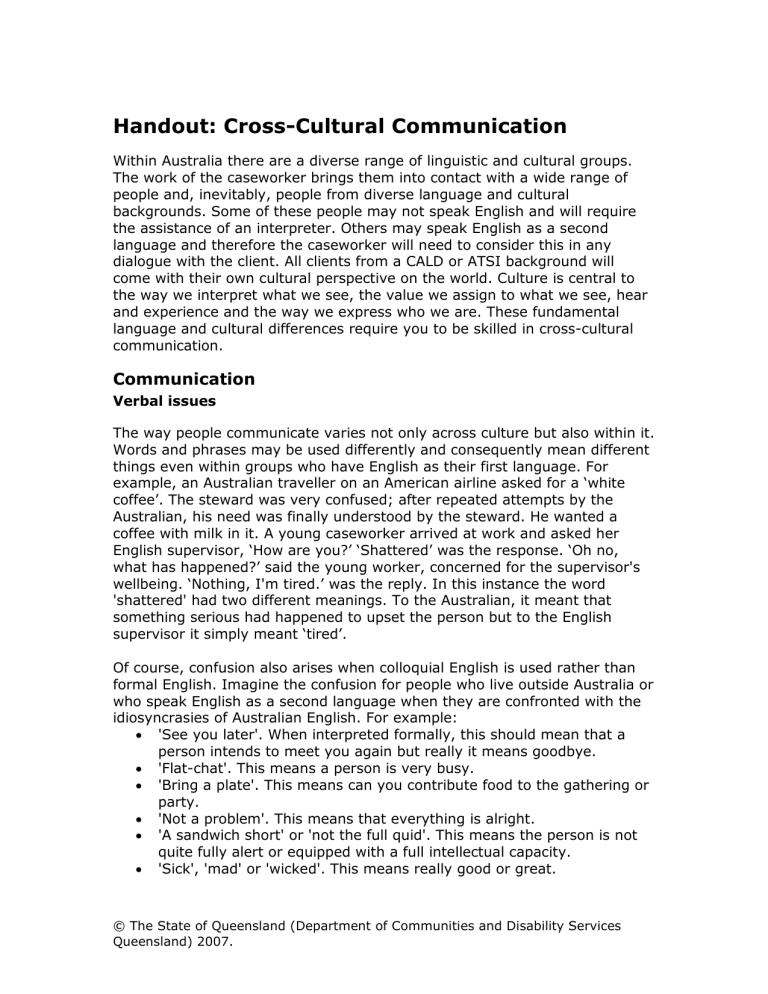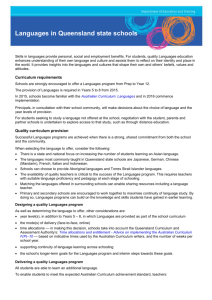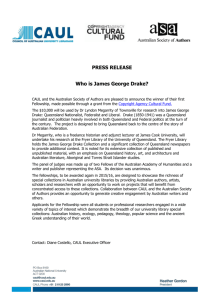Handout 7: Cross Cultural Communication

Handout: Cross-Cultural Communication
Within Australia there are a diverse range of linguistic and cultural groups.
The work of the caseworker brings them into contact with a wide range of people and, inevitably, people from diverse language and cultural backgrounds. Some of these people may not speak English and will require the assistance of an interpreter. Others may speak English as a second language and therefore the caseworker will need to consider this in any dialogue with the client. All clients from a CALD or ATSI background will come with their own cultural perspective on the world. Culture is central to the way we interpret what we see, the value we assign to what we see, hear and experience and the way we express who we are. These fundamental language and cultural differences require you to be skilled in cross-cultural communication.
Communication
Verbal issues
The way people communicate varies not only across culture but also within it.
Words and phrases may be used differently and consequently mean different things even within groups who have English as their first language. For example, an Australian traveller on an American airline asked for a ‘white coffee’. The steward was very confused; after repeated attempts by the
Australian, his need was finally understood by the steward. He wanted a coffee with milk in it. A young caseworker arrived at work and asked her
English supervisor, ‘How are you?’ ‘Shattered’ was the response. ‘Oh no, what has happened?’ said the young worker, concerned for the supervisor's wellbeing. ‘Nothing, I'm tired.’ was the reply. In this instance the word
'shattered' had two different meanings. To the Australian, it meant that something serious had happened to upset the person but to the English supervisor it simply meant ‘tired’.
Of course, confusion also arises when colloquial English is used rather than formal English. Imagine the confusion for people who live outside Australia or who speak English as a second language when they are confronted with the idiosyncrasies of Australian English. For example:
'See you later'. When interpreted formally, this should mean that a person intends to meet you again but really it means goodbye.
'Flat-chat'. This means a person is very busy.
'Bring a plate'. This means can you contribute food to the gathering or party.
'Not a problem'. This means that everything is alright.
'A sandwich short' or 'not the full quid'. This means the person is not quite fully alert or equipped with a full intellectual capacity.
'Sick', 'mad' or 'wicked'. This means really good or great.
© The State of Queensland (Department of Communities and Disability Services
Queensland) 2007.
Non-verbal issues
The norms around the management of time, personal space, level of eye contact and body posture can vary dramatically between cultures.
In Cabramatta, in Sydney's south-west, the police had to be educated about variations in eye contact between Asian Australians and European
Australians. The police, when dealing with young Vietnamese men, were assuming that they were guilty or had something to hide because the young men didn't make eye contact. The young men were in fact avoiding eye contact to demonstrate respect to a person in authority.
Perspective on life
Other differences can also occur in terms of attitudes toward conflict, work, making decisions, disclosing personal information and ways of knowing things.
Western culture is primarily dominated by left-brain thinking. Left-brain thinking is verbal, analytic, symbolic, rational, digital, logical and linear.
Right-brain thinking is less verbal, holistic, more willing to suspend judgement, spatial and intuitive. Indigenous groups in Australia often display these characteristics (Sayer 1988). It is important, when you are working with members of these groups, to be aware of the differences in thinking and communication styles and to account for this when communicating with them.
Strategies for cross-cultural communication
Listen actively and with empathy. Try to see the world from the perspective of the other person.
Suspend judgement.
Learn about your client’s past and the history of their community. Try to identify historical issues or things in their past which may colour their perception of the world or the problem/s they are facing.
If communication breaks down, don't assume your client is on the wrong track. Try to find a way to connect and to make the communication work.
Be aware of the power imbalance. Consider not only language differences but also their class and what your position represents to them.
Find out about cultural norms in body language and posture. Try to adapt and use what you have learned.
Find out about the customs of the people you are working with. This knowledge will make it easier to demonstrate respect and courtesy.
Don't assume you're the expert. Ask your client for advice on their cultural customs if you get stuck.
© The State of Queensland (Department of Communities and Disability Services
Queensland) 2007.
Keep trying to learn. Don't assume that you have ever mastered the skill of cross-cultural communication. Keep asking yourself, ‘Is there a better way?’
Source: Sayer, Barbara 1998, ‘Left or Right brain: Is there a Neurological
Relationship to Traditional Aboriginal Learning Styles?’ in Learning My Way
Papers, from the National Conference on Adult Aboriginal Learning, Perth.
Web Links http://www.jyu.fi/mclinic/cis/cross-cultural.html – DuPraw, M & Axner, M
2002, Working on Common Cross-cultural Communication Challenges.
© The State of Queensland (Department of Communities and Disability Services
Queensland) 2007.




